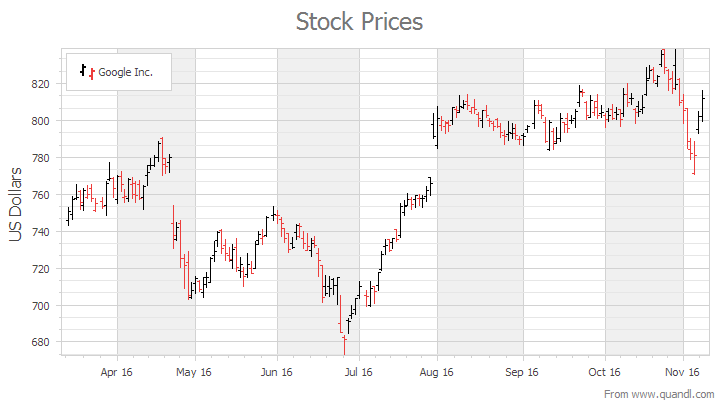Stock Chart
- 5 minutes to read
Short Description
The Stock Chart is represented by the StockSeriesView object, which belongs to Financial Series Views (also called a Low-High-Open-Close chart).
This view shows the variation in stock prices over the course of a day. The Low and High prices are represented by the bottom and top values of the vertical line that is shown at each point, and the Open and Close prices are represented by the left and right tick marks, respectively.
For Stock charts, you can choose for which price level (Low, High, Open, or Close) to enable the FinancialSeriesViewBase.ReductionOptions, which means that if the specified price is lower than the previous point’s value, the subsequent point is painted red (or any other color).
A Stock chart is shown in the image below. Note that this chart type is based upon the XYDiagram, so it can be rotated to show bars either vertically or horizontally.

To learn how to exclude holidays and weekends from an axis scale, refer to the following help topic: Data Aggregation.
For more information on financial charts, see the following help topic: Financial Charting.
Chart Type Characteristics
The table below lists the main characteristics of this chart type.
| Feature | Value |
|---|---|
| Series View type | StockSeriesView |
| Diagram type | 2D-XYDiagram |
| Number of arguments per series point | 1 |
| Number of values per series point | 4 (Low, High, Open, Close) |
Note
For information on which chart types can be combined with the Stock Chart, refer to the following help topic: Combining Different Series Views.
Example
This example creates a ChartControl with a series of the StockSeriesView type, and adds this chart to a form at runtime. Before proceeding with this example, first create a Windows Forms Application in Visual Studio, and add all required assemblies to the project’s References list.
Then, add the following code to the Form.Load event handler.
To exclude non-working days (weekends and holidays) from an axis range, use the DateTimeScaleOptions.WorkdaysOnly and DateTimeScaleOptions.WorkdaysOptions properties. Also, for information on which financial instruments are available in the Chart Control (XtraCharts), refer to the following help topic: Indicators.
using System;
using System.Windows.Forms;
using DevExpress.XtraCharts;
// ...
private void Form1_Load(object sender, EventArgs e) {
// Create a new chart.
ChartControl stockChart = new ChartControl();
// Create a stock series.
Series series1 = new Series("Series 1", ViewType.Stock);
// Specify the date-time argument scale type for the series,
// as it is qualitative, by default.
series1.ArgumentScaleType = ScaleType.DateTime;
// Add points to it.
series1.Points.Add(new SeriesPoint(new DateTime(2017, 3, 1),
new object[] { 24.00, 25.00, 25.00, 24.875 }));
series1.Points.Add(new SeriesPoint(new DateTime(2017, 3, 2),
new object[] { 23.625, 25.125, 24.00, 24.875 }));
series1.Points.Add(new SeriesPoint(new DateTime(2017, 3, 3),
new object[] { 26.25, 28.25, 26.75, 27.00 }));
series1.Points.Add(new SeriesPoint(new DateTime(2017, 3, 6),
new object[] { 26.50, 27.875, 26.875, 27.25 }));
series1.Points.Add(new SeriesPoint(new DateTime(2017, 3, 7),
new object[] { 26.375, 27.50, 27.375, 26.75 }));
series1.Points.Add(new SeriesPoint(new DateTime(2017, 3, 8),
new object[] { 25.75, 26.875, 26.75, 26.00 }));
series1.Points.Add(new SeriesPoint(new DateTime(2017, 3, 9),
new object[] { 25.75, 26.75, 26.125, 26.25 }));
series1.Points.Add(new SeriesPoint(new DateTime(2017, 3, 10),
new object[] { 25.75, 26.375, 26.375, 25.875 }));
series1.Points.Add(new SeriesPoint(new DateTime(2017, 3, 13),
new object[] { 24.875, 26.125, 26.00, 25.375 }));
series1.Points.Add(new SeriesPoint(new DateTime(2017, 3, 14),
new object[] { 25.125, 26.00, 25.625, 25.75 }));
// Add the series to the chart.
stockChart.Series.Add(series1);
// Access the view-type-specific options of the series.
StockSeriesView myView = (StockSeriesView)series1.View;
myView.LineThickness = 2;
myView.LevelLineLength = 0.25;
// Specify the series reduction options.
myView.ReductionOptions.ColorMode = ReductionColorMode.OpenToCloseValue;
myView.ReductionOptions.Level = StockLevel.Close;
myView.ReductionOptions.Visible = true;
// Access the chart's diagram.
XYDiagram diagram = ((XYDiagram)stockChart.Diagram);
// Access the type-specific options of the diagram.
diagram.AxisY.WholeRange.MinValue = 22;
// Exclude weekends from the X-axis range,
// to avoid gaps in the chart's data.
diagram.AxisX.DateTimeScaleOptions.WorkdaysOnly = true;
// Hide the legend (if necessary).
stockChart.Legend.Visibility = DevExpress.Utils.DefaultBoolean.False;
// Add a title to the chart (if necessary).
stockChart.Titles.Add(new ChartTitle());
stockChart.Titles[0].Text = "Stock Chart";
// Add the chart to the form.
stockChart.Dock = DockStyle.Fill;
this.Controls.Add(stockChart);
}